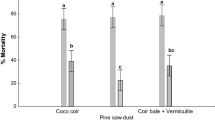Abstract
The relation between log dosage of DD injected at 15 cm depth or of dazomet applied to the soil surface (all in November 1971) and probit mortality ofRotylenchus and trichodorids in the top 20 cm of a field on sandy soil was found to be linear. Dosage increase efficiencies of both chemicals against both nematode species were medium to high. Superficial application of dazomet was very effective against the nematodes that would have survived if only a low dosage of DD had been injected at 15 cm depth. Injection of 40 ml or 80 ml DD per m2 at 15 cm depth killed all nematodes between 20 cm and 60 cm deep.
Gladiolus planted in the spring of 1972 grew better, flowered earlier and produced more weight of corms on treated than on untreated plots. The poor growth on the untreated plots cannot be ascribed to direct damage by nematodes or to the effect of TRV transmitted to the plants by the viruliferous trichodorids occurring in these plots in high densities. Symptoms of TRV infection in plants grown in 1973 from the corms harvested in the 1972 experimental field showed that only DD treatments had reduced the rate of TRV transmission considerably. However, even the highest dosages of DD had only reduced it from 26% (on untreated plots) to about 8%. Most probably, this residual TRV infection was due to transmission by trichodorids that had survived in soil layers below 60 cm depth. Therefore, soil treatment with nematicides, cannot prevent TRV transmission to gladiolus sufficiently where viruliferous trichodorids occur at great depths, as is the case in many sandy soils having a low water table.
Similar content being viewed by others
References
Cremer, M. C. & Schenk, P. K., 1976. Notched leaf inGladiolus spp. caused by viruses of the tobacco rattle virus group. Neth. J. Pl. Path. 73: 33–48.
Cremer, M. C., 1970. Bestrijding vanTrichodorus-aaltjes in verband met de overdracht van ratelvirus. Versl. Lab. Bloemb. Onderz. Lisse, 1969–1970: 40–42.
Hoof, H. A. van, 1965. Toetsmethode van grond op het voorkomen van virusdragende nematoden. J. versl. Inst. Pl. ziektenk. Onderz. 1964: 100.
Seinhorst, J. W., 1965. The relation between nematode density and damage to plants. Nematologica 11: 137–154.
Seinhorst, J. W., 1973. Dosage of nematicidal fumigants and mortality of nematodes. Neth. J. Pl. Path. 79: 180–188.
Seinhorst, J. W., 1973a. The combined effects of dichloropropane-dichloropropene mixture injected into the soil and of dazomet applied to the soil surface. Neth. J. Pl. Path. 79: 194–206.
Seinhorst, J. W., 1973b. The relation between nematode distribution in a field and loss in yield at different average nematode densities. Nematologica 19: 421–427.
Author information
Authors and Affiliations
Rights and permissions
About this article
Cite this article
Seinhorst, J.W., Van Hoof, H.A. The effect of DD and dazomet treatments on nematode populations at various depths in the soil and on the transmission of soil-borne tobacco rattle virus to gladiolus. Neth. J. Pl. Path. 82, 215–230 (1976). https://doi.org/10.1007/BF03041377
Accepted:
Issue Date:
DOI: https://doi.org/10.1007/BF03041377




